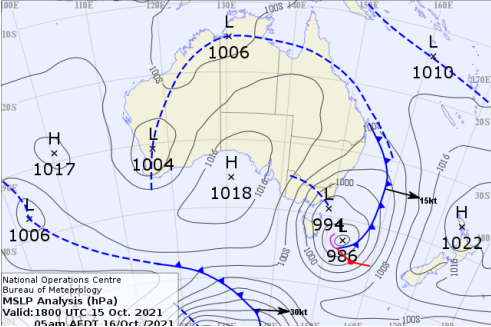Why does our climate constantly change?
Thank you for your question. I think there are two different parts to your question.
The first one may relate to weather rather than climate. Weather and climate are not the same thing. Weather is what happens from one day to the next, and yes, it certainly does change a lot, especially in Tasmania. Climate is the average weather over time.
Let’s talk about weather in Tasmania first. Our weather is affected by processes on a range of scales, and by other factors. One of these important factors in Tasmania is what we call topography – or land form. We have a lot of mountains in the west that rise up to Central Plateau and then in the east the land is generally flatter and lower elevation. Tasmania sits in a region known as the ‘Roaring Forties’ and most of our weather comes from the west
due to the way the atmosphere is ‘organised’. This means that when weather systems hit the west, they drop most of their rain in the west because the clouds carrying the rain have to rise up to get over the mountains. There’s often not much left by the time they get over the Central Plateau.
Another factor is that Tasmania is only a small island. You’ve probably seen weather maps like the one below. Low and high pressure systems pass over Tasmania. Air circulates clockwise around a low pressure system and anticlockwise around a high pressure system. Think about the low pressure system in the map that’s passing over southeastern Australia. If air circles clockwise around this system it means its picking up a lot of moisture from the Tasman sea which then gets dumped along eastern Australia, including Tasmania. As it moves further east – due to dominant westerly winds – we will start to get colder air from further south. If we had a high pressure system passing over Tasmania instead, we would first see winds from the south and then as it passed further to the east, the wind would come from the north. Winds from the north are warmer than winds from the south. Slightly
different locations (e.g. whether they are further south or further north) will also make a difference. So, our weather changes as one system passes over us and sometimes we can get four seasons in one day.

Now, in relation to a constantly changing climate. When we talk a about a changing climate, we’re talking about longer time scales. How long depends on your perspective. For example, people who work with just data that has been measured over the past century would look at trends and change over the past century. Others who study what we can find out about climate from things like sediment, ice cores, tree-rings or corals will look at how climate has changed over hundreds or thousands of years. Some people will look at changes in rainfall and others might look at changes in temperature over land or temperature of the sea.
Just a few things that affect climate over different time scales are:
- Changes in what we call ‘modes of variation’ like El Niño-Southern Oscillation which affects rainfall in eastern Australia in particular (there are other modes of variation, but you’ve probably heard about El Niño – the others are not so often spoken about). El Niño for example has a ‘sort-of’ cycle of about 7 years.
- Human-induced changes like greenhouse gas emissions. Very important factor over the past ~200 years
- Things like sunspots that affect how hot the sun is. Less sunspots mean a cooler sun that then affects how warm Earth is. These can affect Earth’s climate for several decades at a time.
- REALLY long-term changes like how the Earth orbits the sun. This can affect climate at periods of hundreds of thousands of years.
- Big volcanic eruptions – these might affect climate for a few years at a time. But if several big ones occur close together (and depending where they are), the effects might last a decade or more.











